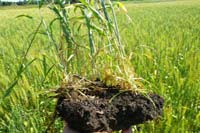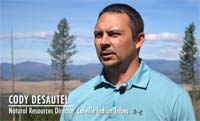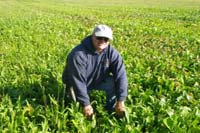Browse our Growing Library of Success Stories
By:
Leopold Conservation Award Program Turkey Creek Ranch, sandwiched between the U.S. Army’s Fort Carson and the growing urban community of Pueblo West, is owned and operated by Gary and Georgia Walker, and consists of approximately 65,000 deeded acres managed for both wildlife and livestock.
Turkey Creek Ranch, sandwiched between the U.S. Army’s Fort Carson and the growing urban community of Pueblo West, is owned and operated by Gary and Georgia Walker, and consists of approximately 65,000 deeded acres managed for both wildlife and livestock.
By:
Leopold Conservation Award Program A deep passion for the land entrusted to them, and a willingness to embrace and adapt to change, has kept the Visintainers at the forefront of innovative ranch management.
A deep passion for the land entrusted to them, and a willingness to embrace and adapt to change, has kept the Visintainers at the forefront of innovative ranch management.
By:
Leopold Conservation Award Program Russell and Tricia Davis’ Wineinger-Davis Ranch, located in Lincoln and Crowley Counties, was established in 1938 as a 400 acre livestock operation. It currently consists of over 12,000 acres. Ranch operations include beef production, birding, ecotourism, agri-tourism, and hunting.
Russell and Tricia Davis’ Wineinger-Davis Ranch, located in Lincoln and Crowley Counties, was established in 1938 as a 400 acre livestock operation. It currently consists of over 12,000 acres. Ranch operations include beef production, birding, ecotourism, agri-tourism, and hunting.
By:
K. Gregg Elliott The nonprofit Soil Health Academy (SHA) is just one of many initiatives spawned by regenerative agriculture guru Gabe Brown in collaboration with additional expert partners. SHA holds regenerative agriculture workshops around the country that are open to anyone who’s interested, and they are routinely sold out.
The nonprofit Soil Health Academy (SHA) is just one of many initiatives spawned by regenerative agriculture guru Gabe Brown in collaboration with additional expert partners. SHA holds regenerative agriculture workshops around the country that are open to anyone who’s interested, and they are routinely sold out.
By:
Gregg Elliott When Heather Dutton, fresh out of undergraduate school at the Warner College of Natural Resources and graduate school in the College of Agriculture at Colorado State University, began her first job working for a non-profit river restoration organization in the San Luis Valley, she was thrilled. She also felt confident that her technical training in restoration ecology had prepared her for the challenges she’d soon be facing.
When Heather Dutton, fresh out of undergraduate school at the Warner College of Natural Resources and graduate school in the College of Agriculture at Colorado State University, began her first job working for a non-profit river restoration organization in the San Luis Valley, she was thrilled. She also felt confident that her technical training in restoration ecology had prepared her for the challenges she’d soon be facing.
Heather was in for a surprise.
By:
Natural Resources Conservation Service This video is the story of a young scientist, Hugh Hammond Bennett, who recognized 80 years ago that the United States was at risk of losing it’s most important resource – its soil. He made it his mission to change the trajectory of agriculture at a time of great crisis and to provide farmers and ranchers with the information and tools they needed to be sustainable.
This video is the story of a young scientist, Hugh Hammond Bennett, who recognized 80 years ago that the United States was at risk of losing it’s most important resource – its soil. He made it his mission to change the trajectory of agriculture at a time of great crisis and to provide farmers and ranchers with the information and tools they needed to be sustainable.
This 21 minute video is the story of the conservation movement that Hugh Hammond Bennett began and includes interesting insights into the policies and structures that he set up that we continue to rely on today. His work revealed so much of what we’re rediscovering and renaming as “regenerative agriculture.”
By:
Washington Policy Center This video from Washington Policy Center with cooperation from the Confederated Tribes of the Colville Reservation, sheds light on how the tribes manage forests to be more healthy using commercial harvests, thinnings, and controlled burns to deal with the pressures of insect infestation, climate change, and decades of fire suppression.
This video from Washington Policy Center with cooperation from the Confederated Tribes of the Colville Reservation, sheds light on how the tribes manage forests to be more healthy using commercial harvests, thinnings, and controlled burns to deal with the pressures of insect infestation, climate change, and decades of fire suppression.
By:
Steve Stuebner Before knowing much about land trusts, Ashton farmer John Nedrow thought they were some kind of sinister force seeking to take over his farm and force landowners off their property.
Before knowing much about land trusts, Ashton farmer John Nedrow thought they were some kind of sinister force seeking to take over his farm and force landowners off their property.
“Back then, I thought they were the enemy,” Nedrow said in an interview on his alfalfa and malt-barley farm, which straddles the banks of the famed Henrys Fork River, a blue-ribbon trout stream. “I thought they wanted to turn this whole area into national park.”
 Their introduction to holistic ranch management techniques called into question long-held, traditional ways of thinking. The drastic changes that followed required a leap of faith for the fourth-generation ranchers. They traded harvesting hay for grazing methods that let their cattle harvest the forage themselves. Such changes didn’t happen overnight, and each came with its own risk and learning curve.
Their introduction to holistic ranch management techniques called into question long-held, traditional ways of thinking. The drastic changes that followed required a leap of faith for the fourth-generation ranchers. They traded harvesting hay for grazing methods that let their cattle harvest the forage themselves. Such changes didn’t happen overnight, and each came with its own risk and learning curve.
By:
K. Gregg Elliott Like almost everyone else in his rural community, Gabe had been farming and ranching using conventional methods since purchasing his Brown’s Ranch from the parents of his wife Shelly in 1991. Possibly because he had not grown up on a farm, Gabe found that he was constantly asking the question, “why do we do things this way?”
Like almost everyone else in his rural community, Gabe had been farming and ranching using conventional methods since purchasing his Brown’s Ranch from the parents of his wife Shelly in 1991. Possibly because he had not grown up on a farm, Gabe found that he was constantly asking the question, “why do we do things this way?”
By:
Northwest Florida Water Management District On March 2, 2018, a large prescribed burn occurred at the Yellow River Water Management Area in Santa Rosa County, Florida, which is managed by the Northwest Florida Water Management District. Weather and atmospheric conditions were ideal and resources were available for the Florida Forest Service to approve the burn permit. Aerial ignition via helicopter started the fire systematically across the landscape. Ground firing and monitoring crews, consisting of 15 personnel were stationed at the tract perimeter as ground support during the burn.
On March 2, 2018, a large prescribed burn occurred at the Yellow River Water Management Area in Santa Rosa County, Florida, which is managed by the Northwest Florida Water Management District. Weather and atmospheric conditions were ideal and resources were available for the Florida Forest Service to approve the burn permit. Aerial ignition via helicopter started the fire systematically across the landscape. Ground firing and monitoring crews, consisting of 15 personnel were stationed at the tract perimeter as ground support during the burn.
By:
USDA Forest Service Over four long days in late March 2011, the most severe wildfire outbreak in a decade occurred at Eglin Air Force Base, located near Destin, Florida (Fig. 1). A persistent drought, 20 mph winds and low humidity, combined with 12-15 arson fires on the property, resulted in 6,000 acres burned in a matter of days. Due to Eglin’s aggressive prescribed fire program, the March 2011 wildfire severity and acres burned were significantly reduced. Without this regular fuel reduction, anywhere from 10-12,000 acres could have burned just on the Eglin side, with untold acres burned and property damaged north of Interstate 10.
Over four long days in late March 2011, the most severe wildfire outbreak in a decade occurred at Eglin Air Force Base, located near Destin, Florida (Fig. 1). A persistent drought, 20 mph winds and low humidity, combined with 12-15 arson fires on the property, resulted in 6,000 acres burned in a matter of days. Due to Eglin’s aggressive prescribed fire program, the March 2011 wildfire severity and acres burned were significantly reduced. Without this regular fuel reduction, anywhere from 10-12,000 acres could have burned just on the Eglin side, with untold acres burned and property damaged north of Interstate 10.
By:
US Forest Service On July 14, 2015, a lightning strike ignited a wildfire on Bald Knob in the Grandfather Ranger District (GRD) of the Pisgah National Forest. Only 30 miles outside of Asheville, North Carolina and on rugged terrain difficult to access, the wildfire may have posed greater threat had it not been adjacent to areas containing recent fuel treatments (prescribed fire) and wildfires. These treatments, as part of the Collaborative Forest Landscape Restoration Program (CFLRP), reduced fire fuel loads in the forest and enabled the Bald Knob fire to safely burn while protecting firefighters, local residents, structures, power line corridors, communication towers, and Forest Service property and surrounding land. Fuel treatments positively influenced the fire’s spread and allowed firefighting efforts to truly focus on protection of private properties. The inaccessible terrain as well as the confine and contain strategy allowed ample time to keep the effected community well informed of current fire behavior, smoke impacts and management plans for the fire.
On July 14, 2015, a lightning strike ignited a wildfire on Bald Knob in the Grandfather Ranger District (GRD) of the Pisgah National Forest. Only 30 miles outside of Asheville, North Carolina and on rugged terrain difficult to access, the wildfire may have posed greater threat had it not been adjacent to areas containing recent fuel treatments (prescribed fire) and wildfires. These treatments, as part of the Collaborative Forest Landscape Restoration Program (CFLRP), reduced fire fuel loads in the forest and enabled the Bald Knob fire to safely burn while protecting firefighters, local residents, structures, power line corridors, communication towers, and Forest Service property and surrounding land. Fuel treatments positively influenced the fire’s spread and allowed firefighting efforts to truly focus on protection of private properties. The inaccessible terrain as well as the confine and contain strategy allowed ample time to keep the effected community well informed of current fire behavior, smoke impacts and management plans for the fire.
By:
CCALT Colorado Cattlemen’s Agricultural Land Trust (CCALT) worked with multiple partners to protect 16,000 acres of key sage grouse habitat on the Cross Mountain Ranch in Moffat County.
Colorado Cattlemen’s Agricultural Land Trust (CCALT) worked with multiple partners to protect 16,000 acres of key sage grouse habitat on the Cross Mountain Ranch in Moffat County.
By:
CCALT Saguache Creek is located in the northwest corner of southern Colorado’s beautiful and agriculturally significant San Luis Valley. The corridor has a long history of sustaining productive ranches.
Saguache Creek is located in the northwest corner of southern Colorado’s beautiful and agriculturally significant San Luis Valley. The corridor has a long history of sustaining productive ranches.
By:
CCALT The 19,000 acre Patterson Ranch near Kim, Colorado represents three generations of a family keeping their agricultural heritage and traditions alive.
The 19,000 acre Patterson Ranch near Kim, Colorado represents three generations of a family keeping their agricultural heritage and traditions alive.
By:
CCALT The Hutchinson family worked to permanently protect nearly the entire ranch. The easement will allow them to transfer the operation of the ranch to the sixth generation of Hutchinsons and will provide the family with the financial resources they need to continue to work the land.
The Hutchinson family worked to permanently protect nearly the entire ranch. The easement will allow them to transfer the operation of the ranch to the sixth generation of Hutchinsons and will provide the family with the financial resources they need to continue to work the land.
By:
CCALT The Cross L Ranch is home to a family-owned commercial hay operation, as well as a large diversity of wildlife, including elk, mule deer, Sandhill cranes and bald eagles. Working with CCALT in 2014, owners John and Tawny Halandras created a conservation easement.
The Cross L Ranch is home to a family-owned commercial hay operation, as well as a large diversity of wildlife, including elk, mule deer, Sandhill cranes and bald eagles. Working with CCALT in 2014, owners John and Tawny Halandras created a conservation easement.
By:
CCALT Since 2007, CCALT has partnered with several ranching families to conserve over 20,000 acres of working, productive ranchland in North Park.
Since 2007, CCALT has partnered with several ranching families to conserve over 20,000 acres of working, productive ranchland in North Park.
 The Ladder Ranch is a working sheep, cattle and hay ranch headquartered along the Colorado-Wyoming border, northwest of Steamboat Springs, Colorado and east of Savery, Wyoming. The operation has evolved from a survival mode pioneer enterprise to a significant production and conservation ranch.
The Ladder Ranch is a working sheep, cattle and hay ranch headquartered along the Colorado-Wyoming border, northwest of Steamboat Springs, Colorado and east of Savery, Wyoming. The operation has evolved from a survival mode pioneer enterprise to a significant production and conservation ranch.